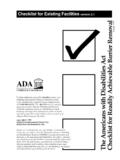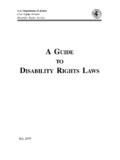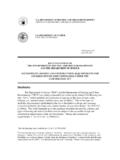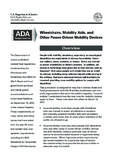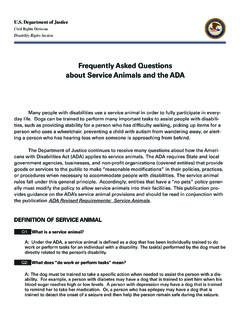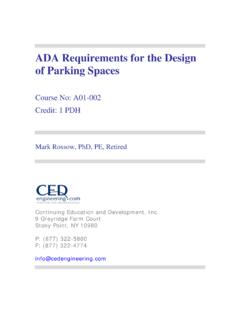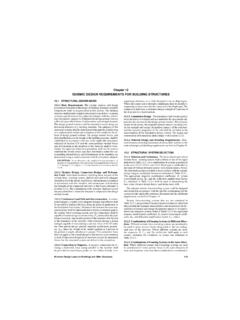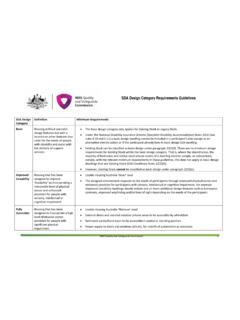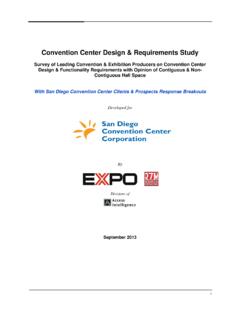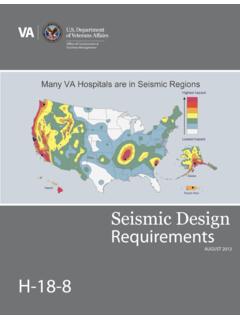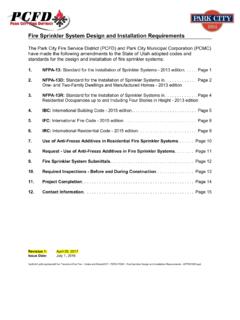Transcription of U.S. DEPARTMENT OF JUSTICE - ADA
1 DEPARTMENT OF HOUSING AND URBAN DEVELOPMENT OFFICE OF FAIR HOUSING AND EQUAL OPPORTUNITY DEPARTMENT OF JUSTICE CIVIL RIGHTS DIVISION Washington, April 30, 2013 JOINT STATEMENT OF THE DEPARTMENT OF HOUSING AND URBAN DEVELOPMENT AND THE DEPARTMENT OF JUSTICE ACCESSIBILITY ( design AND CONSTRUCTION) requirements FOR COVERED MULTIFAMILY DWELLINGS UNDER THE FAIR HOUSING ACT Introduction The DEPARTMENT of JUSTICE ( DOJ ) and the DEPARTMENT of Housing and Urban Development ( HUD ) are jointly responsible for enforcing the federal Fair Housing Act (the Act ),1 which prohibits discrimination in housing on the basis of race, color, religion, sex, national origin, familial status, and One of the types of disability discrimination prohibited by the Act is the failure to design and construct covered multifamily dwellings with certain features of accessible design .
2 See 42 3604(f). This Joint Statement provides guidance regarding the persons, entities, and types of housing and related facilities that are subject to the accessible design and construction requirements of the Act (hereinafter, design and construction requirements ). See 42 3604(f)(3). 1 The Fair Housing Act is codified at 42 3601-3619. 2 The Act uses the term handicap instead of disability. Both terms have the same legal meaning. See Bragdon v. Abbott, 524 624, 631 (1998) (noting that definition of disability in the Americans with Disabilities Act is drawn almost verbatim from the definition of handicap contained in the Fair Housing Amendments Act of 1988 ). This document uses the term disability, which is more generally accepted. 2 This Joint Statement does not focus on the specific technical criteria that must be followed to comply with the design and construction requirements because HUD has already provided rulemaking and specific technical guidance to the public on those criteria.
3 See HUD regulations implementing the design and construction provisions at 24 et seq.; Final Fair Housing Accessibility Guidelines ( Guidelines ), 56 Fed. Reg. 9,472 (Mar. 6, 1991); Supplement to Notice of Fair Housing Accessibility Guidelines: Questions and Answers about the Guidelines ( Questions and Answers ), 59 Fed. Reg. 33,362 (June 28, 1994); Fair Housing Act design Manual ( design Manual ) (August 1996, Revised April 1998)3. For additional technical assistance, see the Fair Housing Act Accessibility FIRST website, This Joint Statement also does not focus on the accessibility requirements applicable to housing and related facilities under Section 504 of the Rehabilitation Act of 1973, the Americans with Disabilities Act (1990), the Architectural Barriers Act (1968), and state or local laws. Housing providers involved in designing and constructing covered multifamily dwellings are also subject to the other nondiscrimination provisions of the Fair Housing Act, including the obligations to provide reasonable accommodations and allow reasonable modifications.
4 See Joint Statement of the DEPARTMENT of Housing and Urban Development and the DEPARTMENT of JUSTICE , Reasonable Accommodations under the Fair Housing Act (May 17, 2004) and Joint Statement of the DEPARTMENT of Housing and Urban Development and the DEPARTMENT of JUSTICE , Reasonable Modifications under the Fair Housing Act (Mar. 5, 2008), at or Further information about all of the Fair Housing Act s nondiscrimination requirements is available on HUD s Fair Housing website, which may be accessed at , and DOJ s Fair Housing website, which may be accessed at QUESTIONS AND ANSWERS Accessibility requirements of the Fair Housing Act 1. What are the accessible features required by the Act? The Act requires that covered multifamily dwellings be designed and constructed with the following accessible features: The public and common use areas must be readily accessible to and usable by persons with disabilities; All doors designed to allow passage into and within all premises of covered dwellings must be sufficiently wide to allow passage by persons with disabilities, including persons who use wheelchairs; All premises within covered dwellings must contain the following features: o An accessible route into and through the dwelling unit; 3 All references to the Fair Housing Act design Manual are to the August 1996 edition revised and republished April 1998.
5 3 o Light switches, electrical outlets, thermostats, and other environmental controls in accessible locations; o Reinforcements in bathroom walls to allow the later installation of grab bars; o Usable kitchens and bathrooms such that an individual using a wheelchair can maneuver about and use the space. See 42 3604(f)(3)(C). To describe these requirements in more detail, HUD published the Fair Housing Act regulations ( Regulations ) at 24 Part 100 on January 23, 1989, the Guidelines on March 6, 1991, the Questions and Answers on June 28, 1994, and the design Manual (issued in 1996 and revised and republished in 1998). In the Guidelines, the above statutory provisions appear as seven requirements , as follows: Requirement 1. Accessible building entrance on an accessible route. Requirement 2. Accessible and usable public and common use areas.
6 Requirement 3. Usable doors. Requirement 4. Accessible route into and through the covered dwelling unit. Requirement 5. Light switches, electrical outlets, thermostats and other environmental controls in accessible locations. Requirement 6. Reinforced walls for grab bars. Requirement 7. Usable kitchens and bathrooms. Types of Dwellings Covered by the Act 2. What types of housing are covered by the Fair Housing Act s design and construction requirements ? The Fair Housing Act requires all covered multifamily dwellings designed and constructed for first occupancy after March 13, 1991, to be readily accessible to and usable by persons with disabilities. In buildings with four or more dwelling units and at least one elevator, all dwelling units and all public and common use areas are subject to the Act s design and construction requirements .
7 In buildings with four or more dwelling units and no elevator, all ground floor units and public and common use areas are subject to the Act s design and construction requirements . 4 The term covered multifamily dwelling is defined by the Act and its implementing regulations and covers many different types of residential buildings and Dwellings subject to the Act s design and construction requirements include condominiums, cooperatives, apartment buildings, vacation and time share units, assisted living facilities, continuing care facilities, nursing homes, public housing developments, HOPE VI projects, projects funded with HOME or other federal funds, transitional housing, single room occupancy units (SROs), shelters designed as a residence for homeless persons, dormitories, hospices, extended stay or residential hotels, and more.
8 Housing or some portion of housing covered by the Act s design and construction requirements may be subject to additional accessibility requirements under other laws. Those laws include Section 504 of the Rehabilitation Act, the Americans with Disabilities Act, the Architectural Barriers Act, and state or local laws. 3. What standards are used to determine whether a housing facility that includes short-term residencies is covered by the Act s design and construction requirements ? Whether a housing facility that includes short-term residencies is a dwelling under the Act depends on whether the facility is intended to be used as a residence for more than a brief period of time. As a result, the operation of each housing facility needs to be examined carefully to determine whether it is intended to contain dwellings. Factors to be considered in determining whether a facility contains dwellings include, but are not limited to: (1) the length of time persons will stay in the project; (2) whether the rental rate for the unit will be calculated on a daily, weekly, monthly or yearly basis; (3) whether the terms and length of occupancy will be established through a lease or other written agreement; (4) how the property will be described to the public in marketing materials; (5) what amenities will be included inside the unit, including kitchen facilities; (6) whether the resident will possess the right to return to the property; and (7) whether the resident will have anywhere else to return.
9 See Final Report of HUD Review of Model Building Codes, 65 Fed. Reg. 15,740, 15,746-47 (Mar. 23, 2000). See also preamble to the final rule implementing the Fair Housing Amendments Act of 1988, stating that the definition of dwelling is broad enough to cover each of the types of dwellings enumerated in the proposed rule: mobile home parks, trailer courts, condominiums, cooperatives, and time-sharing properties. 54 Fed. Reg. 3,232, 3,238 (Jan. 23, 1989). 4. Do the Fair Housing Act s design and construction requirements , or any other laws mandating accessible design , apply to detached single family homes? The Fair Housing Act s design and construction requirements apply only to covered multifamily dwellings -- that is, buildings having four or more dwelling units built for first occupancy after March 13, 1991. This includes both rental and sale units and also attached single family homes when there are four or more dwellings in the building ( , 4 The federal regulation specifying the types of residential buildings and facilities that are subject to the design and construction requirements of the Act appears at 24 5 condominiums).
10 Detached single family houses as well as duplexes and triplexes are not covered by the Act s design and construction requirements . See 42 3604(f)(3)(C), (f)(7). Condominiums that are not detached are, however, covered. Preamble to the Guidelines, 56 Fed. Reg. at 9,481. However, any housing (including single family detached homes) constructed by federal, state, or local government entities or constructed using any federal, state, or local funds may be subject to accessibility requirements under laws other than the Fair Housing Act. These laws -- particularly Section 504 of the Rehabilitation Act of 1973, Title II of the Americans with Disabilities Act, and the Architectural Barriers Act -- have requirements for accessibility that exceed those contained in the Fair Housing Act. In addition, state and local building codes may contain accessibility requirements for detached single family homes and/or other housing.
